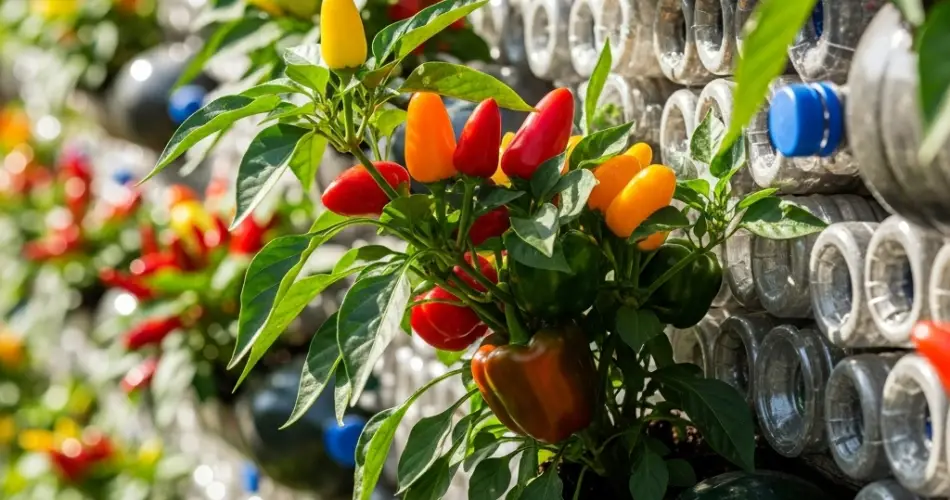Peppers are one of the most rewarding crops to grow at home—whether you prefer sweet bell peppers or fiery hot chilis. But what if you don’t have space for a traditional garden? No problem. You can grow peppers vertically using recycled plastic bottles mounted on a wall or fence. This simple yet effective method is perfect for small spaces and turns everyday waste into a productive and beautiful garden feature.
Vertical bottle gardening not only saves ground space but also improves air circulation, keeps fruit off the soil, and allows for easy access when watering, pruning, or harvesting. With the right materials and care, you can enjoy homegrown peppers in even the smallest urban settings.
Why Grow Peppers in Bottled Wall Gardens?
Here are several reasons to try this space-efficient method:
-
Space-saving – Great for balconies, patios, small backyards, or narrow alleys
-
Eco-conscious – Reuses plastic bottles that would otherwise go to waste
-
Improved airflow – Reduces the risk of fungal diseases and pests
-
Easier maintenance – Makes it easier to prune, inspect, and harvest
-
Aesthetic appeal – Turns walls and fences into colorful vertical gardens
-
Modular and customizable – Easy to add more bottles or rearrange as needed
This technique is ideal for gardeners with limited space and a desire to grow fresh produce at home.
Best Pepper Varieties for Vertical Growing
When choosing pepper varieties for vertical bottles, opt for compact or bushy types that thrive in containers. Here are a few good choices:
-
Sweet Peppers:
-
Mini Bell – Small, sweet, and colorful
-
Lunchbox Peppers – Snack-sized and productive
-
California Wonder – Classic blocky pepper, suitable for containers
-
-
Hot Peppers:
-
Cayenne – Slim, spicy, and grows well in pots
-
Thai Chili – Compact and very prolific
-
Jalapeño – Mild to medium heat and very adaptable
-
Habanero – For those who love extra heat (requires a bigger container)
-
Choose based on your flavor preferences and the amount of sunlight your wall garden receives.
What You’ll Need
To start your vertical pepper garden, collect the following:
-
1.5 or 2-liter plastic bottles (clean, with caps)
-
Sharp knife or scissors
-
Quality potting mix with compost
-
Organic fertilizer or compost tea
-
Pepper seedlings or seeds
-
Wall, fence, or wooden frame
-
Screws, wire, or sturdy string for mounting
-
Optional: mulch for moisture retention
Step 1: Prepare the Bottles
-
Clean each bottle thoroughly and remove any labels.
-
Cut a window on one side of the bottle—roughly 4–5 inches long and 2–3 inches wide—for planting.
-
Add drainage holes – Poke small holes at the bottom of the bottle and near the cap to allow excess water to escape.
-
Make mounting holes near the top and bottom to tie or screw the bottles securely to a vertical surface.
Add a few stones or gravel to the bottom for extra drainage if desired.
Step 2: Add Soil and Plant Peppers
Fill each bottle with a light, well-draining potting mix enriched with compost. Peppers need loose soil to develop strong roots.
If starting from seed, plant 1–2 seeds per bottle about ¼ inch deep. If using seedlings, carefully transplant one healthy plant per bottle, keeping the root ball intact.
Water gently after planting.
Step 3: Mount the Bottles
Attach your planted bottles to a wall, fence, or pallet. Use strong wire, zip ties, or screws to ensure they’re secure. Leave enough space between bottles to allow for air circulation and light exposure.
Place your garden in a location that receives at least 6 hours of sunlight per day. South-facing walls are ideal.
Step 4: Watering and Feeding
Peppers need consistent moisture but don’t like soggy roots. Water when the top inch of soil feels dry. Bottles dry out faster than traditional containers, so check regularly—especially during hot weather.
Fertilize every 2–3 weeks with a diluted organic liquid fertilizer or compost tea to support flowering and fruit development.
Step 5: Pruning and Support
Some pepper plants may grow tall and top-heavy, even in bottles. If necessary, stake them with a small bamboo stick or tie the stem to the bottle with soft string.
Pinch off the growing tips early on to encourage bushier growth and more fruiting branches. Remove any yellow or damaged leaves to keep the plant healthy.
Step 6: Harvesting Peppers
Peppers are ready to harvest when they reach full size and color. Green peppers can be picked early, but letting them ripen on the plant (to red, orange, or yellow) will enhance sweetness and flavor.
Use scissors or garden snips to cut the fruits, leaving a short stem attached. Regular harvesting encourages more fruit production.
Step 7: Replant and Rotate
After harvesting, remove spent plants and refresh the soil mix with compost. Replant a new pepper or rotate with a different crop like basil or lettuce to maintain healthy soil and prevent nutrient depletion.
Final Thoughts
Growing peppers vertically in bottled wall gardens is a creative and eco-friendly solution for producing fresh food in tight spaces. This method not only saves room but also adds a touch of greenery and productivity to any vertical surface.
Whether you love sweet bells or fiery hot chilis, a wall of recycled plastic bottles can give you a continuous supply of homegrown peppers. It’s a smart, sustainable, and satisfying way to garden—no backyard required.



